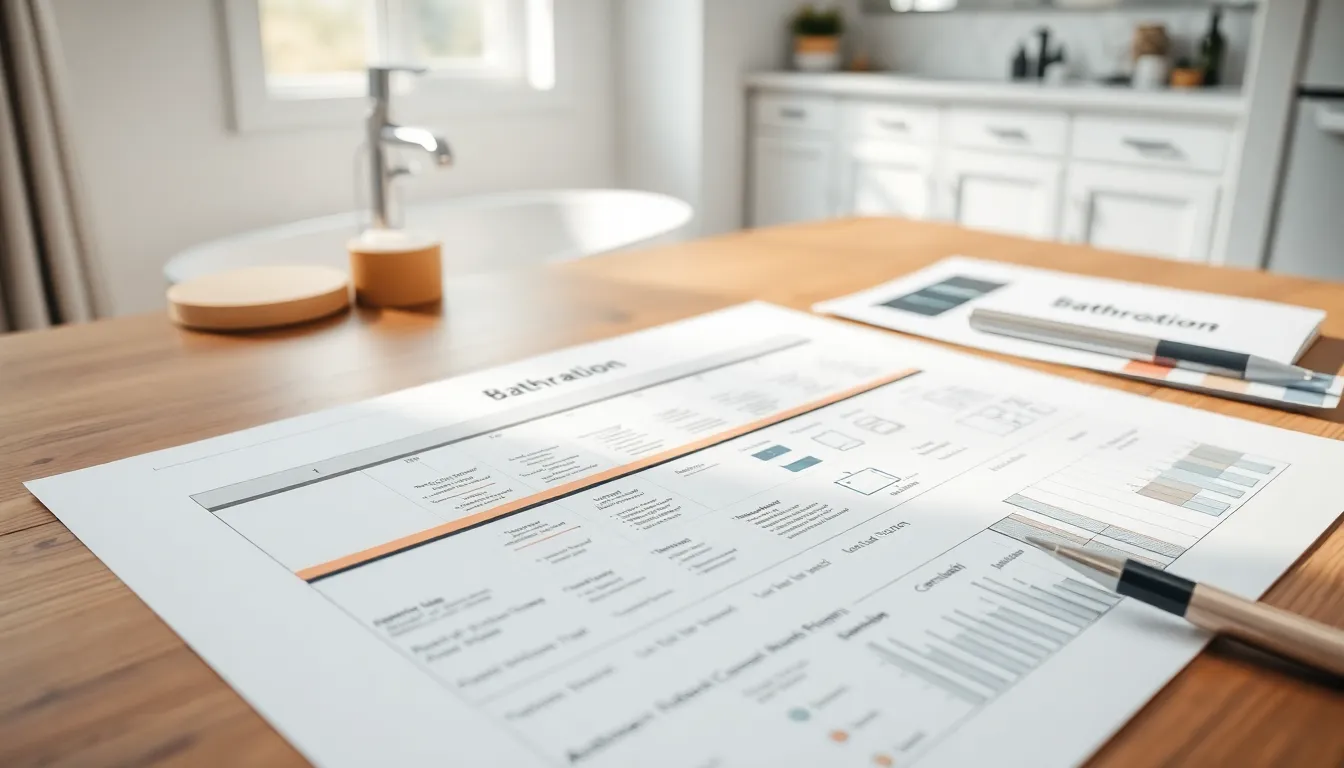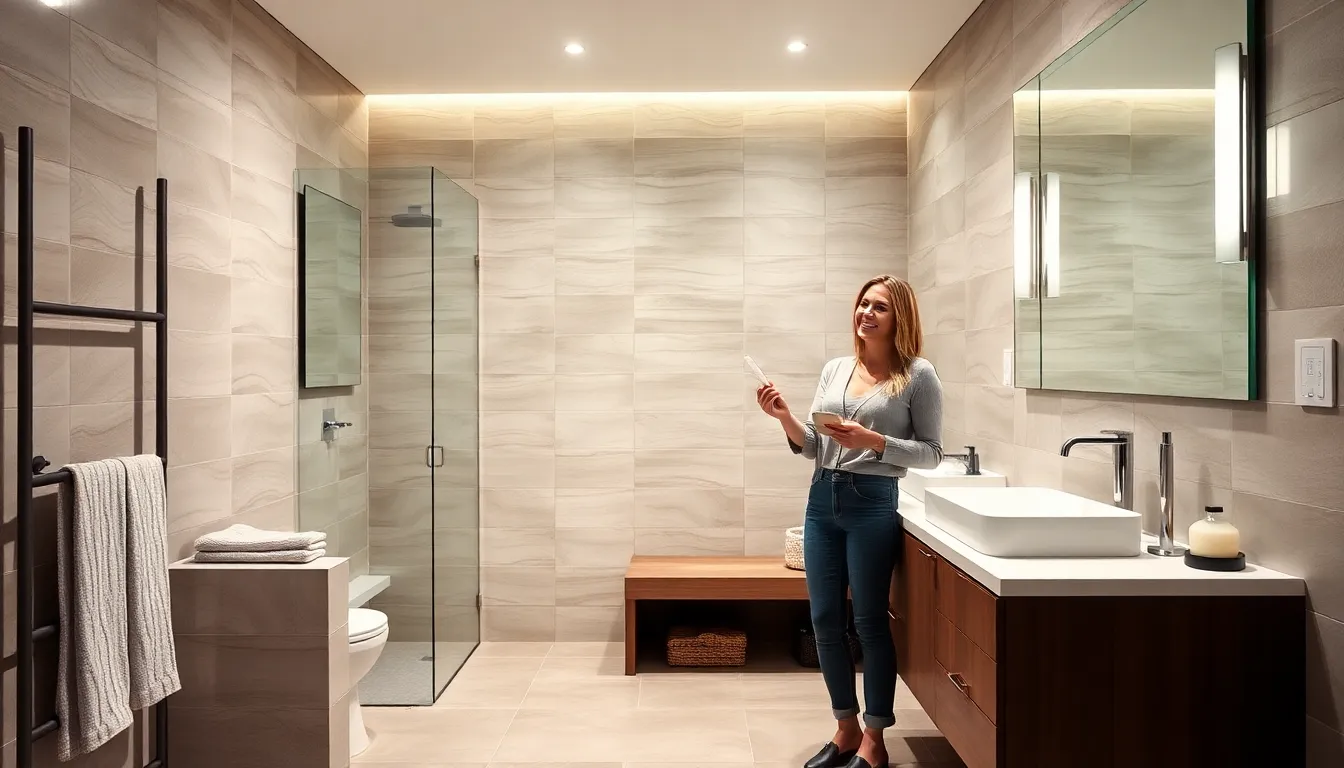Renovating a bathroom can feel like preparing for a marathon—exciting yet daunting. With dreams of a spa-like retreat dancing in their heads, many dive into the renovation process without a clear timeline. Spoiler alert: chaos often ensues. Imagine trying to brush your teeth in the kitchen while dodging a rogue contractor wielding a sledgehammer.
Table of Contents
ToggleUnderstanding Bathroom Renovation Timeline
A bathroom renovation involves multiple steps that require careful planning. Organizing a timeline can streamline the process and reduce stress.
Key Phases of Renovation
Several key phases define the renovation process. First, planning establishes goals and selects materials. Next, demolition removes old fixtures and finishes. After that, plumbing and electrical work ensure all systems are functional. Following installation, the focus shifts to tiling, painting, and cabinetry. Finally, the finishing touches, such as hardware and decor, make the bathroom complete.
Typical Duration for Each Phase
Each phase varies in duration based on project complexity. Planning generally takes one to two weeks. Demolition usually lasts one week. Expect plumbing and electrical work to require one to three weeks, depending on existing conditions. Installation of tiles and cabinetry often spans two to four weeks. Finally, finishing touches may take an additional week. In total, renovations can take anywhere from four to eight weeks.
Planning Your Renovation

Planning a bathroom renovation requires careful consideration. A clear timeline makes a significant difference in achieving smooth execution.
Setting a Realistic Timeline
Each phase of the renovation process must be allocated sufficient time. Planning generally takes one to two weeks. Demolition usually lasts about one week. Plumbing and electrical work can span one to three weeks. Installation may take two to four weeks to complete. Finishing touches often require an additional week. Overall, the full renovation typically ranges from four to eight weeks. Establishing a realistic timeline conserves energy and reduces stress.
Factors That Affect Duration
Multiple factors can influence the duration of a bathroom renovation. Scope of the project significantly affects timelines. Custom fixtures or high-end materials may increase the renovation period. Weather conditions can also cause delays, especially with external work. Availability of contractors plays a vital role; busy schedules may extend project timelines. Last-minute design changes can disrupt progress and result in further delays. Understanding these variables helps in creating an effective timeline.
Execution of the Renovation
The execution phase transforms plans into reality. This phase consists of demolition, installation, and finishing touches, each essential for a successful bathroom renovation.
Demolition and Preparation
Demolition lasts about one week. Contractors start by removing old fixtures, tiles, and cabinetry. They carefully dispose of debris to maintain a safe work environment. Following this, preparation occurs, including necessary repairs to walls or plumbing. The space is then primed for the next stages of renovation. Proper preparation ensures that installation runs smoothly. All these steps create a solid foundation for the installation phase.
Installation Process
Installation may take two to four weeks. Plumbers and electricians install crucial components, ensuring all systems operate correctly. After the plumbing and electrical work, contractors add flooring, cabinetry, and countertops. Fixtures such as sinks, toilets, and showers come next. Attention to detail is vital during this phase to guarantee high-quality results. Each element significantly influences the overall function and aesthetics of the bathroom.
Final Touches and Cleanup
Final touches typically require one additional week. Contractors paint walls, install accessories, and perform final inspections. Cleanup follows, allowing the space to shine. During this phase, any remaining debris gets cleared away. It’s crucial to ensure that everything meets design specifications and operational standards. A thorough cleanup leaves a pristine bathroom ready for use.
Common Pitfalls to Avoid
Bathroom renovations can easily derail without careful attention to specific challenges. Recognizing these pitfalls helps streamline the process and improves the outcome.
Misestimating Time and Costs
Many homeowners underestimate both time and costs during bathroom renovations. Planning phases often take one to two weeks, but potential surprises can arise, complicating timelines. Creating a detailed budget before starting the project can prevent unexpected expenses from causing stress. Custom fixtures and high-end materials typically cost more and can extend renovation timelines. Setting a realistic financial limit helps prioritize spending, ensuring that essential elements receive necessary funding. This approach minimizes the stress experienced during the renovation and keeps the project on track.
Not Allowing for Delays
Delays are common in bathroom renovations, often stemming from unforeseen issues. Contractors may face scheduling conflicts, resulting in delays that extend the project timeline. Weather conditions also contribute to setbacks, especially for external work. Last-minute design changes can disrupt progress and affect the project schedule. Preparing for potential delays by allocating extra time within the renovation timeline keeps the project manageable. By anticipating hiccups, the overall experience becomes smoother and less stressful, allowing homeowners to enjoy their newly renovated space.
Renovating a bathroom is an exciting journey that requires careful planning and execution. By understanding the timeline and phases involved, homeowners can navigate the process with confidence. A well-structured timeline not only helps in managing expectations but also minimizes stress throughout the renovation.
Being aware of potential delays and challenges allows for better preparation and resource allocation. With a clear plan in place, homeowners can transform their bathrooms into beautiful and functional spaces without unnecessary complications. Embracing this structured approach ensures a smoother renovation experience and ultimately leads to a satisfying outcome.




